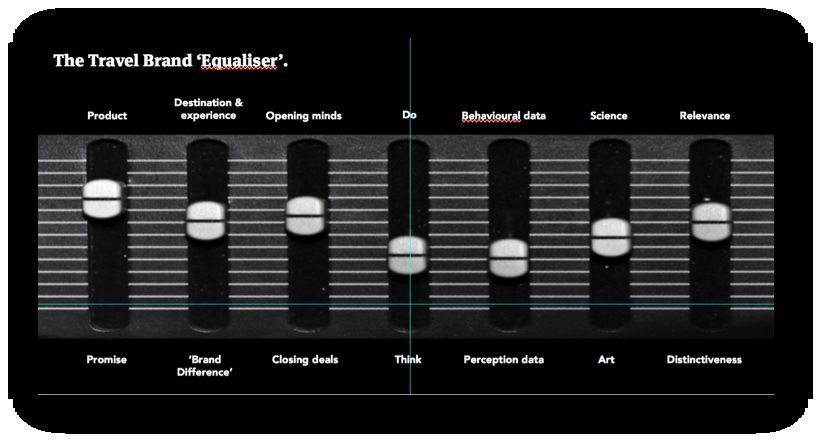Travel Brands Need A North Star More Than Most
Feb 18, 2018
By Tony Evans, Head of Planning | BJL , United Kingdom | tony.evans@bjl.co.uk
As travel brands seek to attract and convert increasingly savvy travelers and holiday-makers, they have to consider a huge number of variables all of which can exert influence on the likelihood of securing a sale.
The challenge can be likened to a sound-engineer tweaking the levels on their mixing desks, but instead of the various instruments levels being adjusted, it's the levels of spend behind different types of activity.
The Travel Brand Equaliser below gives an indication of some of the choices that need to be navigated.

To elaborate on the extent of challenge - it's worth considering some of those choices and balancing acts.
1. The product and the promise.
Firstly, everything a brand does influences people's perceptions - whether that's the quality of the accommodation on offer or the conversation you had with the customer services representative. Optimising these will enhance the experience of those who use them, which in turn will increase the likelihood of satisfaction, repeat business and even endorsement. Conversely, poor customer experiences can damage a brand very quickly if people share their dissatisfaction publicly, which many travellers in particular do. And our own research revealed that 46% of the UK population would't make a choice without consulting reviews. However, people need to be made aware of what a brand has to offer or there won't be anyone to experience it, however good to bad it is. So, how good does the travel experience need to be before it can be promoted? Or, how many shortcomings can you get away with when promoting your offering. At what point does addressing the shortcomings becoming a priority over all else?
The destination/product/experience and the 'brand difference'.
What exactly should a brand promote? People tend to think about where they want to go and/or what they want to do, and this informs how they go about searching for, and ultimately making their travel or holiday choice.
In this context travel brands have to balance being a potential solution to people's research and exerting their difference or superiority or value relative to others who supply that same need.
2. Data - what people do and what people think.
An understanding of customer behaviours as well as their perceptions can help to shed light on how marketing needs to balance its investments.
One of the biggest developments in recent years has been the explosion in availability and use of behavioural data (a by-product of the explosion of online activity), which has revolutionised the travel brand marketing. It has ushered in a whole new era of science and sophistication into the discipline - helping with decision-making and driving efficiencies.
This data doesn't necessarily tell the whole story. The reality is, people might do things, but they may not like doing them. People may pay extra for a benefit such as WIFI, but that doesn't mean they like doing so. Indeed this may impact future consideration.
Over-reliance on any one source of data can present risks.
3. Science versus art.
The use of behavioural data helps to guide marketing activity. It probably helps to drive effectiveness and helping marketers determine what best practice it.
However, a risk associated with the pursuit of best practice is the way it can reduce the options that are pursued. It can be a reductive process that needs to be balanced with willingness to experiment and explore to ensure marketing activities don't become tired and too limited.
So What?
To ensure these different types of activity are truly integrated to drive business success, a number of things are needed:
1. Brands need a North Star to ensure all activity pulls in the same direction.
At BJL we develop what we call a 'Brand Rally Cry', which is developed and there to ensure the brand is something everyone understands and that everyone can get behind - internally and externally.
Brand Rally Cries sit above specific communications propositions and as a result guide all behaviour and to make it easier for marketing choices to be made: they serve as both the inspiration and filter for all a brand's activity.
2. This needs to be coupled with a forensic understanding of the consumer journey (where it's working well and where it isn't) to help determine where marketing intervention is needed and an integrated capability that means all interventions can be realised.
Finally, there needs to be an understanding that everything a travel brand does is 'brand' activity. This is perhaps truer in travel than in any other category. And this makes it all the more important to have a Rally Cry.
Follow us on social media via the links below and discover all of our Travelations here .
If you would like to speak to one of Tribe's travel experts, or would like to view our travel/tourism credentials, please email Elaine here .
Tribe Global is a network of over 30 independent agencies and business Partners working together with an overwhelming passion for solving client challenges creatively, with a commercial imperative. Travelations are for travel marketers seeking global perspective, actionable insights and business advantage. For more Travelations and examples of our deep Tribal travel/tourism experience, find us at tribeglobal.net.







